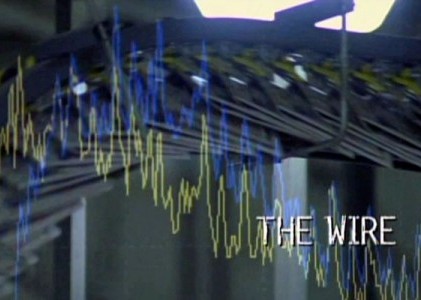Extra Credit, Part 1
Making The Wire, Museum of the Moving Image, July 30, 2008
This video essay is part of a series on The Wire. Also on Moving Image Source: Dana Polan on the show's Balzacian universe, Nelson George on its complex portrayal of black America, David Schwartz on its view of life as a chess game, and video essays on the Season 2, Season 3, Season 4, and Season 5 credits by Andrew Dignan, Kevin B. Lee, and Matt Zoller Seitz.
The following text is the voiceover script for the video essay on The Wire's Season 1 credits.
The credits for the first season of The Wire use police iconography and staged crime-scene footage to convey the down-and-dirty feel of Baltimore's killing streets. With the fanfare of an industrial training video, we see gel caps being assembled, dealers positioning themselves in driver's side windows, and the body language of a back-alley handoff. Cut to the song "Way Down in the Hole" as performed by the gospel group Blind Boys of Alabama, the sequence announces that The Wire is not a kicking-down-doors-and-busting-heads kind of cop show. The compositions are often off-center or partly out-of-focus, conveying world weariness and tedium on both sides of the divide. Instead of armories or kevlar vests, the credits display affidavits, court orders, mug shots, antiquated surveillance equipment, and people dragging on cigarettes to pass the time.
The sequence shows the series' fondness for counterintelligence and misdirection while setting the stage for a battle of wills in which neither side is inclined to lay down and die. In the most memorable shot, and one of the few to be integrated into every season's credits, we watch two dealers literally bringing down a surveillance camera with a projectile; it's a display of defiance and a reminder that both sides are aware of the other's tactics.
There's a patient and persistent atmosphere to the sequence, exemplified by its protracted running time. The credits display as much insight into, and respect for, the process of maintaining a criminal empire and evading prosecution as they do for honest police work. A dialogue is brokered between law enforcement and those seeking to undermine it.
The cutting creates symmetry through juxtaposition. A pay phone call in which a dealer orders a re-up of drugs is followed by a shot of an officer listening in through an earpiece. Bisecting the frame in both shots is the titular wire. Two men on opposite sides of the law, dependent on one another: the cop needs the criminal, and the criminal is only forced to employ cloak-and-dagger tactics because of the cop. —A.D. ![]()
LATEST ARTICLES
-20140814-173707-thumb3.jpg)
Fighting Words
by Imogen Sara Smith
posted August 12, 2014

Fighting Words, Part 2
by Imogen Sara Smith
posted August 20, 2014

On the Margins: The Fil…
by Andrew Chan
posted August 12, 2014

Robin Williams: A Sense…
by David Schwartz
posted August 12, 2014
 The Wire's Season 1 credits
The Wire's Season 1 credits
RELATED ARTICLE
Extra Credit, Part 2 by Andrew Dignan, Kevin B. Lee and Matt Zoller SeitzExtra Credit, Part 3 by Andrew Dignan, Kevin B. Lee and Matt Zoller Seitz
Extra Credit, Part 4 by Andrew Dignan, Kevin B. Lee and Matt Zoller Seitz
Extra Credit, Part 5 by Andrew Dignan, Kevin B. Lee and Matt Zoller Seitz
Invisible City by Dana Polan
Across Racial Lines by Nelson George
Kings and Pawns by David Schwartz
More: Article Archive
THE AUTHORS
Andrew Dignan is a film producer and occasional blogger living in Los Angeles. His last film, the Sundance selection Steel City, is now on DVD and he is currently in pre-production on two features and a short scheduled to shoot this fall.
More articles by Andrew DignanKevin B. Lee is editor of the Keyframe journal at Fandor and programming executive at dGenerate Films.
More articles by Kevin B. LeeMatt Zoller Seitz is a writer and filmmaker whose debut feature, the romantic comedy Home, is available through Netflix and Amazon. His writing on film and television has appeared in The New York Times, New York Press, and The Star Ledger, among other places. He is also the founder of The House Next Door, a movie and TV criticism website.
More articles by Matt Zoller SeitzAuthor's Website: The House Next Door

